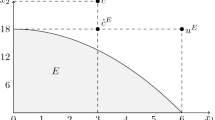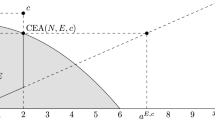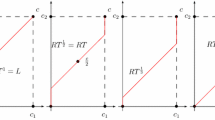Abstract
This paper studies bankruptcy problems with nontransferable utility as a generalization of bankruptcy problems with monetary estate and claims. Following the theory on TU-bankruptcy, we introduce a duality notion for NTU-bankruptcy rules and derive several axiomatic characterizations of the proportional rule and the constrained relative equal awards rule.
Similar content being viewed by others
Notes
In other words, the strong Pareto set coincides with the weak Pareto set. This condition is also called strict comprehensiveness (see e.g. Roemer 1998).
Note that \((\lambda ^{E,c-f(E,c)}E,c)\in \mathrm{BR}^N\) since \(\lambda ^{E,c-f(E,c)}\in (0,\lambda ^{E,c})\).
References
Aumann, R., & Maschler, M. (1985). Game theoretic analysis of a bankruptcy problem from the Talmud. Journal of Economic Theory, 36(2), 195–213.
Borm, P., Carpente, L., Casas-Méndez, B., & Hendrickx, R. (2005). The constrained equal awards rule for bankruptcy problems with a priori unions. Annals of Operations Research, 137(1), 211–227.
Carpente, L., Casas-Méndez, B., Gozálvez, J., Llorca, N., Pulido, M., & Sánchez-Soriano, J. (2013). How to divide a cake when people have different metabolism? Mathematical Methods of Operations Research, 78(3), 361–371.
Chun, Y. (1988). The proportional solution for rights problems. Mathematical Social Sciences, 15(3), 231–246.
Chun, Y., & Thomson, W. (1992). Bargaining problems with claims. Mathematical Social Sciences, 24(1), 19–33.
Dagan, N. (1996). New characterizations of old bankruptcy rules. Social Choice and Welfare, 13(1), 51–59.
Dietzenbacher, B. (2018). Bankruptcy games with nontransferable utility. Mathematical Social Sciences, 92, 16–21.
Dietzenbacher, B., Borm, P., & Estévez-Fernández, A. (2020). NTU-bankruptcy problems: Consistency and the relative adjustment principle. Review of Economic Design, 24(1), 101–122.
Estévez-Fernández, A., Borm, P., & Fiestras-Janeiro, M. (2020). Nontransferable utility bankruptcy games. TOP, 28(1), 154–177.
Herrero, C., & Villar, A. (2001). The three musketeers: four classical solutions to bankruptcy problems. Mathematical Social Sciences, 42(3), 307–328.
Herrero, C., & Villar, A. (2002). Sustainability in bankruptcy problems. TOP, 10(2), 261–273.
Mariotti, M., & Villar, A. (2005). The Nash rationing problem. International Journal of Game Theory, 33(3), 367–377.
Moulin, H., & Shenker, S. (1992). Serial cost sharing. Econometrica, 60(5), 1009–1037.
O’Neill, B. (1982). A problem of rights arbitration from the Talmud. Mathematical Social Sciences, 2(4), 345–371.
Orshan, G., Valenciano, F., & Zarzuelo, J. (2003). The bilateral consistent prekernel, the core, and NTU bankruptcy problems. Mathematics of Operations Research, 28(2), 268–282.
Pulido, M., Borm, P., Hendrickx, R., Llorca, N., & Sánchez-Soriano, J. (2008). Compromise solutions for bankruptcy situations with references. Annals of Operations Research, 158(1), 133–141.
Pulido, M., Sánchez-Soriano, J., & Llorca, N. (2002). Game theory techniques for university management: an extended bankruptcy model. Annals of Operations Research, 109, 129–142.
Roemer, J. (1998). Theories of distributive justice. Cambridge: Harvard University Press.
Thomson, W. (2003). Axiomatic and game-theoretic analysis of bankruptcy and taxation problems: A survey. Mathematical Social Sciences, 45(3), 249–297.
Thomson, W. (2013). Game-theoretic analysis of bankruptcy and taxation problems: recent advances. International Game Theory Review, 15(3), 1340018.
Thomson, W. (2015). Axiomatic and game-theoretic analysis of bankruptcy and taxation problems: An update. Mathematical Social Sciences, 74, 41–59.
Yeh, C. (2004). Sustainability, exemption, and the constrained equal awards rule: A note. Mathematical Social Sciences, 47(1), 103–110.
Yeh, C. (2006). Protective properties and the constrained equal awards rule for claims problems: A note. Social Choice and Welfare, 27(2), 221–230.
Young, H. (1988). Distributive justice in taxation. Journal of Economic Theory, 44(2), 321–335.
Acknowledgements
Support from the Basic Research Program of the National Research University Higher School of Economics is gratefully acknowledged. Two anonymous referees are gratefully acknowledged for helpful comments and suggestions.
Author information
Authors and Affiliations
Corresponding author
Additional information
Publisher's Note
Springer Nature remains neutral with regard to jurisdictional claims in published maps and institutional affiliations.
Appendix
Appendix
Proof of Theorem 2
-
(i)
Let \((E,c)\in \mathrm{BR}^N\) and let \(t\in (0,1)\). Then
$$\begin{aligned} \mathrm{Prop}(tE,c)=\frac{1}{\lambda ^{tE,c}}c=t\frac{1}{\lambda ^{E,c}}c=t\mathrm{Prop}(E,c). \end{aligned}$$Hence, the proportional rule satisfies path linearity. Let f be a bankruptcy rule satisfying path linearity. Let \((E,c)\in \mathrm{BR}^N\). Then
$$\begin{aligned} f(E,c)=f\left( \frac{1}{\lambda ^{E,c}}\lambda ^{E,c}E,c\right) =\frac{1}{\lambda ^{E,c}}f(\lambda ^{E,c}E,c)=\frac{1}{\lambda ^{E,c}}c=\mathrm{Prop}(E,c). \end{aligned}$$Hence, \(f=\mathrm{Prop}\).
-
(ii)
By Theorem 1(i), the proportional rule satisfies self-duality. By Theorem 2(i), the proportional rule satisfies path composition down. Let f be a bankruptcy rule satisfying path composition down and self-duality. Let \((E,c)\in \mathrm{BR}^N\). By path continuity, there is a \(t\in (0,\lambda ^{E,c})\) such that \(\sum _{i\in N}f_i(tE,c)=\frac{1}{2}\sum _{i\in N}c_i\). By self-duality, \(c-f(tE,c)=f(\lambda ^{E,c-f(tE,c)}E,c)\). This means that
$$\begin{aligned} \sum _{i\in N}f_i\Big (\lambda ^{E,c-f(tE,c)}E,c\Big )=\sum _{i\in N}c_i-\sum _{i\in N}f_i(tE,c)=\frac{1}{2}\sum _{i\in N}c_i. \end{aligned}$$By path monotonicity, \(t=\lambda ^{E,c-f(tE,c)}\) and \(f(tE,c)=f(\lambda ^{E,c-f(tE,c)}E,c)\). This means that \(t=\frac{1}{2}\lambda ^{E,c}\) and \(f(tE,c)=\frac{1}{2}c\). Similarly, \(f(\frac{1}{2}\lambda ^{E,\frac{1}{2}c}E,\frac{1}{2}c)=\frac{1}{4}c\). By path composition down,
$$\begin{aligned} f\Big (\tfrac{1}{4}\lambda ^{E,c}E,c\Big )= & {} f\Big (\tfrac{1}{4}\lambda ^{E,c}E,f\Big (\tfrac{1}{2}\lambda ^{E,c}E,c\Big )\Big )=f\Big (\tfrac{1}{4}\lambda ^{E,c}E,\tfrac{1}{2}c\Big )\\= & {} f\Big (\tfrac{1}{2}\lambda ^{E,\tfrac{1}{2}c}E,\tfrac{1}{2}c\Big )=\tfrac{1}{4}c. \end{aligned}$$By self-duality,
$$\begin{aligned} f\Big (\tfrac{3}{4}\lambda ^{E,c}E,c\Big )= & {} f\Big (\lambda ^{E,\tfrac{3}{4}c}E,c\Big )=f\left( \lambda ^{E,c-f\Big (\tfrac{1}{4}\lambda ^{E,c}E,c\Big )}E,c\right) \\= & {} c-f\Big (\tfrac{1}{4}\lambda ^{E,c}E,c\Big )=\tfrac{3}{4}c. \end{aligned}$$Continuing this reasoning, \(f(\frac{m}{2^n}\lambda ^{E,c}E,c)=\frac{m}{2^n}c\) for all \(m,n\in \mathbb {N}\) with \(m\le 2^n\). By path continuity, \(f(t\lambda ^{E,c}E,c)=tc\) for all \(t\in (0,1)\). Hence, \(f(E,c)=\mathrm{Prop}(E,c)\).
-
(iii)
By Theorem 1(i), the proportional rule satisfies self-duality. By Theorem 2(i), the proportional rule satisfies path composition up. Let f be a bankruptcy rule satisfying path composition up and self-duality. By Lemma 2(ii), f satisfies path composition down and self-duality. By Theorem 2(ii), \(f=\mathrm{Prop}\).
Proof of Theorem 3
-
(i)
Let \((E,c)\in \mathrm{BR}^N\) and let \(i,j\in N\) such that \(\frac{c_i}{u_i^E}=\frac{c_j}{u_j^E}\). Then
$$\begin{aligned} \frac{\mathrm{CREA}_i(E,c)}{u_i^E}= & {} \frac{\min \{c_i,\alpha ^{E,c}u_i^E\}}{u_i^E} = \min \left\{ \frac{c_i}{u_i^E},\alpha ^{E,c}\right\} \\= & {} \min \left\{ \frac{c_j}{u_j^E},\alpha ^{E,c}\right\} = \frac{\min \{c_j,\alpha ^{E,c}u_j^E\}}{u_j^E}=\frac{\mathrm{CREA}_j(E,c)}{u_j^E}. \end{aligned}$$Hence, the constrained relative equal awards rule satisfies relative symmetry. Let \((E,c)\in \mathrm{BR}^N\). For all \(i\in N\),
$$\begin{aligned} \mathrm{CREA}_i(E,\hat{c}^E)= & {} \min \{\hat{c}_i^E,\alpha ^{E,\hat{c}^E}u_i^E\} = \min \{\min \{c_i,u_i^E\},\alpha ^{E,\hat{c}^E}u_i^E\} \\= & {} \min \{c_i,u_i^E,\alpha ^{E,\hat{c}^E}u_i^E\} = \min \{c_i,\alpha ^{E,\hat{c}^E}u_i^E\}. \end{aligned}$$Since E is nonleveled, this means that \(\mathrm{CREA}(E,c)=\mathrm{CREA}(E,\hat{c}^E)\). Hence, the constrained relative equal awards rule satisfies truncation invariance. Let \((E,c)\in \mathrm{BR}^N\) and let \(t\in (0,1)\). For all \(i\in N\), \(\mathrm{CREA}_i(tE,c)=\min \{c_i,t\alpha ^{tE,c}u_i^E\}\). This means that \(\mathrm{CREA}(tE,c)\le \mathrm{CREA}(E,c)\). Denote \(d=\lambda ^{E,\mathrm{CREA}(E,c)-\mathrm{CREA}(tE,c)}\). Suppose that \(d\alpha ^{dE,c-\mathrm{CREA}(tE,c)}\le \alpha ^{E,c}-t\alpha ^{tE,c}\). For all \(i\in N\) with \(\mathrm{CREA}_i(tE,c)=c_i\),
$$\begin{aligned} \mathrm{CREA}_i(dE,c-\mathrm{CREA}(tE,c))=0=c_i-c_i=\mathrm{CREA}_i(E,c)-\mathrm{CREA}_i(tE,c). \end{aligned}$$For all \(i\in N\) with \(\mathrm{CREA}_i(tE,c)=t\alpha ^{tE,c}u_i^E\),
$$\begin{aligned} \mathrm{CREA}_i(dE,c-\mathrm{CREA}(tE,c))= & {} \min \left\{ c_i-\mathrm{CREA}_i(tE,c),\alpha ^{dE,c-\mathrm{CREA}(tE,c)}u_i^{dE}\right\} \\= & {} \min \left\{ c_i-t\alpha ^{tE,c}u_i^E,d\alpha ^{dE,c-\mathrm{CREA}(tE,c)}u_i^E\right\} \\\le & {} \min \left\{ c_i-t\alpha ^{tE,c}u_i^E,\alpha ^{E,c}u_i^E-t\alpha ^{tE,c}u_i^E\right\} \\= & {} \min \left. \{c_i,\alpha ^{E,c}u_i^E\}-t\alpha ^{tE,c}u_i^E \right. \\= & {} \mathrm{CREA}_i(E,c)-\mathrm{CREA}_i(tE,c). \end{aligned}$$Since E is nonleveled, \(\mathrm{CREA}(dE,c-\mathrm{CREA}(tE,c))\in \mathrm{P}(dE)\), and \(\mathrm{CREA}(E,c)-\mathrm{CREA}(tE,c)\in \mathrm{P}(dE)\), this means that
$$\begin{aligned} \mathrm{CREA}(dE,c-\mathrm{CREA}(tE,c))=\mathrm{CREA}(E,c)-\mathrm{CREA}(tE,c). \end{aligned}$$Clearly, similar arguments apply to the case \(d\alpha ^{dE,c-\mathrm{CREA}(tE,c)}>\alpha ^{E,c}-t\alpha ^{tE,c}\). Hence, the constrained relative equal awards rule satisfies path composition up. Let f be a bankruptcy rule satisfying relative symmetry, truncation invariance, and path composition up. Let \((E,c)\in \mathrm{BR}^N\). Suppose that \(f(tE,c)\ne \mathrm{CREA}(tE,c)\) for some \(t\in [0,\lambda ^{E,c}]\). Define \(\hat{t}=\inf \{t\in [0,\lambda ^{E,c}]\mid f(tE,c)\ne \mathrm{CREA}(tE,c)\}\). By path continuity, \(\hat{t}\in [0,\lambda ^{E,c})\) and \(f(\hat{t}E,c)=\mathrm{CREA}(\hat{t}E,c)\). Denote \(N=\{1,\ldots ,|N|\}\) such that \(\frac{c_1}{u_1^E}\le \cdots \le \frac{c_{|N|}}{u_{|N|}^E}\). Let \(k\in N\) be such that \(f_i(\hat{t}E,c)=c_i\) for all \(i<k\), and \(f_i(\hat{t}E,c)=\hat{t}\alpha ^{\hat{t}E,c}u_i^E<c_i\) for all \(i\ge k\). Define \(m=\min \{\Vert x\Vert \mid x\in \mathrm{P}(E)\}\). Let \(\varepsilon \in (0,m(\frac{c_k}{u_k^E}-\frac{f_k(\hat{t}E,c)}{u_k^E}))\). By path continuity, there is a \(\delta >0\) such that \(\Vert f(tE,c)-f(\hat{t}E,c)\Vert <\varepsilon \) for all \(t\in (\hat{t},\min \{\hat{t}+\delta ,\lambda ^{E,c}\})\). Let \(t\in (\hat{t},\min \{\hat{t}+\delta ,\lambda ^{E,c}\})\). By path monotonicity, \(\lambda ^{E,f(tE,c)-f(\hat{t}E,c)}\in (0,\lambda ^{E,c})\). Denote \(d=\lambda ^{E,f(tE,c)-f(\hat{t}E,c)}\). By path composition up,
$$\begin{aligned} m\left( \frac{c_k}{u_k^E}-\frac{f_k(\hat{t}E,c)}{u_k^E}\right)>\varepsilon >\Vert f(tE,c)-f(\hat{t}E,c)\Vert =\Vert f(dE,c-f(\hat{t}E,c))\Vert \ge dm. \end{aligned}$$This means that \(d<(\frac{c_k}{u_k^E}-\frac{f_k(\hat{t}E,c)}{u_k^E})\). Define \(\tilde{u}^{dE}\in \mathbb {R}_+^N\) by
$$\begin{aligned} \tilde{u}_i^{dE}= {\left\{ \begin{array}{ll} 0&{}{{\text {for}}\;{\text {all}}\;i < k;} \\ {u_i^{dE}}&{}{{\text {for}}\;{\text {all}}\;i \ge k.} \end{array}\right. } \end{aligned}$$For all \(i<k\),
$$\begin{aligned} \tilde{u}_i^{dE}=0=c_i-c_i=c_i-f_i(\hat{t}E,c)=c_i-\mathrm{CREA}_i(\hat{t}E,c). \end{aligned}$$For all \(i\ge k\),
$$\begin{aligned} \tilde{u}_i^{dE}= & {} u_i^{dE}=du_i^E < \left( \frac{c_k}{u_k^E}-\frac{f_k(\hat{t}E,c)}{u_k^E}\right) u_i^E \le \left( \frac{c_i}{u_i^E}-\frac{\hat{t}\alpha ^{\hat{t}E,c}u_k^E}{u_k^E}\right) u_i^E \\= & {} c_i-\hat{t}\alpha ^{\hat{t}E,c}u_i^E = c_i-f_i(\hat{t}E,c) = c_i-\mathrm{CREA}_i(\hat{t}E,c). \end{aligned}$$By truncation invariance and relative symmetry,
$$\begin{aligned} f\big (dE,c-f(\hat{t}E,c)\big )= & {} f\big (dE,\tilde{u}^{dE}\big ) = \frac{1}{\lambda ^{dE,\tilde{u}^{dE}}}\tilde{u}^{dE} \\= & {} \mathrm{CREA}\big (dE,\tilde{u}^{dE}\big ) = \mathrm{CREA}\big (dE,c-\mathrm{CREA}(\hat{t}E,c)\big ). \end{aligned}$$By composition up,
$$\begin{aligned} f(tE,c)= & {} f(\hat{t}E,c)+f(dE,c-f(\hat{t}E,c)) \\= & {} \mathrm{CREA}(\hat{t}E,c)+\mathrm{CREA}(dE,c-\mathrm{CREA}(\hat{t}E,c)) \\= & {} \mathrm{CREA}(tE,c). \end{aligned}$$This contradicts the definition of \(\hat{t}\). Hence, \(f(tE,c)=\mathrm{CREA}(tE,c)\) for all \(t\in [0,\lambda ^{E,c}]\).
-
(ii)
Let \((E,c)\in \mathrm{BR}^N\) and let \(i\in N\) with \(c_i'>c_i\). If \(\alpha ^{E,(c_i',c_{N\setminus \{i\}})}\ge \alpha ^{E,c}\), then
$$\begin{aligned} \mathrm{CREA}_i(E,(c_i',c_{N\setminus \{i\}}))=\min \{c_i',\alpha ^{E,(c_i',c_{N\setminus \{i\}})}u_i^E\}\ge \min \{c_i,\alpha ^{E,c}u_i^E\}=\mathrm{CREA}_i(E,c). \end{aligned}$$Suppose that \(\alpha ^{E,(c_i',c_{N\setminus \{i\}})}<\alpha ^{E,c}\). For all \(j\in N\setminus \{i\}\),
$$\begin{aligned} \mathrm{CREA}_j(E,(c_i',c_{N\setminus \{i\}}))= & {} \min \{c_j,\alpha ^{E,(c_i',c_{N\setminus \{i\}})}u_j^E\}\le \min \{c_j,\alpha ^{E,c}u_j^E\}\\= & {} \mathrm{CREA}_j(E,c). \end{aligned}$$Since E is nonleveled, this means that \(\mathrm{CREA}_i(E,c')\ge \mathrm{CREA}_i(E,c)\). Hence, the constrained relative equal awards rule satisfies claim monotonicity. Let \((E,c)\in \mathrm{BR}^N\) and let \(i\in N\) with
$$\begin{aligned} \left( \min \left\{ \frac{c_i}{u_i^E},\frac{c_j}{u_j^E}\right\} u_j^E\right) _{j\in N}\in E. \end{aligned}$$Suppose that \(\mathrm{CREA}_i(E,c)=\alpha ^{E,c}u_i^E\). For all \(j\in N\),
$$\begin{aligned} \mathrm{CREA}_j(E,c)=\min \{c_j,\alpha ^{E,c}u_j^E\}=\min \left\{ \alpha ^{E,c},\frac{c_j}{u_j^E}\right\} u_j^E\le \min \left\{ \frac{c_i}{u_i^E},\frac{c_j}{u_j^E}\right\} u_j^E. \end{aligned}$$Since E is nonleveled, this means that \(\mathrm{CREA}_i(E,c)=c_i\). Hence, the constrained relative equal awards rule satisfies conditional full compensation. Let f be a bankruptcy rule satisfying claim monotonicity and conditional full compensation. Let \((E,c)\in \mathrm{BR}^N\). Let \(i\in N\) with \(\mathrm{CREA}_i(E,c)=c_i\). For all \(j\in N\),
$$\begin{aligned} \min \left\{ \frac{c_i}{u_i^E},\frac{c_j}{u_j^E}\right\} u_j^E\le \min \left\{ \alpha ^{E,c},\frac{c_j}{u_j^E}\right\} u_j^E=\min \{c_j,\alpha ^{E,c}u_j^E\}=\mathrm{CREA}_j(E,c). \end{aligned}$$Since E is comprehensive, this means that
$$\begin{aligned} \left( \min \left\{ \frac{c_i}{u_i^E},\frac{c_j}{u_j^E}\right\} u_j^E\right) _{j\in N}\in E. \end{aligned}$$By conditional full compensation, \(f_i(E,c)=c_i\). Suppose that \(f(E,c)\ne \mathrm{CREA}(E,c)\). Since E is nonleveled, there is a \(k\in N\) with \(f_k(E,c)<\mathrm{CREA}_k(E,c)=\alpha ^{E,c}u_k^E<c_k\). Define \(c_k'=\alpha ^{E,c}u_k^E\). For all \(j\in N\),
$$\begin{aligned} \min \left\{ \frac{c_k'}{u_k^E},\frac{c_j}{u_j^E}\right\} u_j^E=\min \left\{ \alpha ^{E,c},\frac{c_j}{u_j^E}\right\} u_j^E=\min \{c_j,\alpha ^{E,c}u_j^E\}=\mathrm{CREA}_j(E,c). \end{aligned}$$This means that
$$\begin{aligned} \left( \min \left\{ \frac{c_k'}{u_k^E},\frac{c_j}{u_j^E}\right\} u_j^E\right) _{j\in N}\in E. \end{aligned}$$By conditional full compensation, \(f_k(E,(c_k',c_{N\setminus \{k\}}))=c_k'\). Then \(f_k(E,(c_k',c_{N\setminus \{k\}}))>f_k(E,c)\), contradicting claim monotonicity. Hence, \(f(E,c)=\mathrm{CREA}(E,c)\).
-
(iii)
By Theorem 3(ii), the constrained relative equal awards rule satisfies conditional full compensation. Let \((E,c)\in \mathrm{BR}^N\) and let \(t\in (0,1)\). For all \(i\in N\), \(\mathrm{CREA}_i(tE,c)=\min \{c_i,t\alpha ^{tE,c}u_i^E\}\). This means that \(\mathrm{CREA}(tE,c)\le \mathrm{CREA}(E,c)\). Suppose that \(\alpha ^{tE,\mathrm{CREA}(E,c)}\le \alpha ^{tE,c}\). For all \(i\in N\),
$$\begin{aligned} \mathrm{CREA}_i(tE,\mathrm{CREA}(E,c))= & {} \min \{\mathrm{CREA}_i(E,c),\alpha ^{tE,\mathrm{CREA}(E,c)}u_i^{tE}\} \\\le & {} \min \{\min \{c_i,\alpha ^{E,c}u_i^E\},\alpha ^{tE,c}u_i^{tE}\} \\= & {} \min \{\min \{c_i,\alpha ^{E,c}u_i^E\},\min \{c_i,\alpha ^{tE,c}u_i^{tE}\}\} \\= & {} \min \{\mathrm{CREA}_i(E,c),\mathrm{CREA}_i(tE,c)\} \\= & {} \mathrm{CREA}_i(tE,c). \end{aligned}$$Since E is nonleveled, \(\mathrm{CREA}(tE,\mathrm{CREA}(E,c))\in \mathrm{P}(tE)\), and \(\mathrm{CREA}(tE,c)\in \mathrm{P}(tE)\), this means that \(\mathrm{CREA}(tE,\mathrm{CREA}(E,c))=\mathrm{CREA}(tE,c)\). Clearly, similar arguments apply to the case \(\alpha ^{tE,\mathrm{CREA}(E,c)}>\alpha ^{tE,c}\). Hence, the constrained relative equal awards rule satisfies path composition down. Let f be a bankruptcy rule satisfying conditional full compensation and path composition down. Let \((E,c)\in \mathrm{BR}^N\). Let \(i\in N\) with \(\mathrm{CREA}_i(E,c)=c_i\). For all \(j\in N\),
$$\begin{aligned} \min \left\{ \frac{c_i}{u_i^E},\frac{c_j}{u_j^E}\right\} u_j^E\le \min \left\{ \alpha ^{E,c},\frac{c_j}{u_j^E}\right\} u_j^E=\min \{c_j,\alpha ^{E,c}u_j^E\}=\mathrm{CREA}_j(E,c). \end{aligned}$$Since E is comprehensive, this means that
$$\begin{aligned} \left( \min \left\{ \frac{c_i}{u_i^E},\frac{c_j}{u_j^E}\right\} u_j^E\right) _{j\in N}\in E. \end{aligned}$$By conditional full compensation, \(f_i(E,c)=c_i\). Suppose that \(f(E,c)\ne \mathrm{CREA}(E,c)\). Since E is nonleveled, there is a \(k\in N\) with \(f_k(E,c)<\mathrm{CREA}_k(E,c)=\alpha ^{E,c}u_k^E<c_k\). By path monotonicity and path continuity, there is a \(t\in (1,\lambda ^{E,c})\) such that \(f_k(tE,c)=\alpha ^{E,c}u_k^E\). For all \(j\in N\),
$$\begin{aligned} \min \left\{ \frac{f_k(tE,c)}{u_k^E},\frac{f_j(tE,c)}{u_j^E}\right\} u_j^E\le \min \left\{ \alpha ^{E,c},\frac{c_j}{u_j^E}\right\} u_j^E=\mathrm{CREA}_j(E,c). \end{aligned}$$Since E is comprehensive, this means that
$$\begin{aligned} \left( \min \left\{ \frac{f_k(tE,c)}{u_k^E},\frac{f_j(tE,c)}{u_j^E}\right\} u_j^E\right) _{j\in N}\in E. \end{aligned}$$By conditional full compensation, \(f_k(E,f(tE,c))=f_k(tE,c)\). By path composition down, \(f_k(E,c)=f_k(tE,c)\). This is a contradiction. Hence, \(f(E,c)=\mathrm{CREA}(E,c)\).
-
(iv)
By Theorem 3(i), the constrained relative equal awards rule satisfies relative symmetry. Let \((E,c)\in \mathrm{BR}^N\) and let \(i,j\in N\) with \(i\ne j\) and \(\frac{c_j'}{u_j^E}>\frac{c_j}{u_j^E}\ge \frac{c_i}{u_i^E}\). Suppose that \(\alpha ^{E,(c_j',c_{N\setminus \{j\}})}\ge \alpha ^{E,c}\). For all \(k\in N\),
$$\begin{aligned} \mathrm{CREA}_k(E,(c_j',c_{N\setminus \{j\}}))\ge \min \{c_k,\alpha ^{E,c}u_k^E\}=\mathrm{CREA}_k(E,c). \end{aligned}$$Since E is nonleveled, this means that \(\mathrm{CREA}(E,(c_j',c_{N\setminus \{j\}}))=\mathrm{CREA}(E,c)\). Now suppose that \(\alpha ^{E,(c_j',c_{N\setminus \{j\}})}<\alpha ^{E,c}\). For all \(k\in N\setminus \{j\}\),
$$\begin{aligned} \mathrm{CREA}_k(E,(c_j',c_{N\setminus \{j\}}))\le \min \{c_k,\alpha ^{E,c}u_k^E\}=\mathrm{CREA}_k(E,c). \end{aligned}$$Suppose that \(\mathrm{CREA}_i(E,(c_j',c_{N\setminus \{j\}}))<\mathrm{CREA}_i(E,c)\). Then \(\alpha ^{E,(c_j',c_{N\setminus \{j\}})}<\frac{c_i}{u_i^E}\). Since E is nonleveled, \(\mathrm{CREA}_j(E,(c_j',c_{N\setminus \{j\}}))>\mathrm{CREA}_j(E,c)\). Then \(\alpha ^{E,(c_j',c_{N\setminus \{j\}})}>\frac{c_j}{u_j^E}\). This is a contradiction. Hence, \(\mathrm{CREA}_i(E,(c_j',c_{N\setminus \{j\}}))=\mathrm{CREA}_i(E,c)\) and the constrained relative equal awards rule satisfies independence of larger relative claims. Let f be a bankruptcy rule satisfying relative symmetry and independence of larger relative claims. Let \((E,c)\in \mathrm{BR}^N\). Denote \(N=\{1,\ldots ,|N|\}\) such that \(\frac{c_1}{u_1^E}\le \cdots \le \frac{c_{|N|}}{u_{|N|}^E}\). Let \(k\in N\) be such that \(\mathrm{CREA}_i(E,c)=c_i\) for all \(i<k\), and \(\mathrm{CREA}_i(E,c)=\alpha ^{E,c}u_i^E<c_i\) for all \(i\ge k\). For all \(i<k\), by independence of larger relative claims,
$$\begin{aligned} f_i(E,c)=f_i(E,\mathrm{CREA}(E,c))=\mathrm{CREA}_i(E,c). \end{aligned}$$For all \(i\ge k\), define \(c^i\in \mathbb {R}_+^N\) by
$$\begin{aligned} c_j^i= {\left\{ \begin{array}{ll} {{c_j}}&{}{{\text {for}}\;{\text {all}}\;j \le i;} \\ {\frac{{{c_i}}}{{u_i^E}}u_j^E}&{}{{\text {for}}\;{\text {all}}\;j > i.} \end{array}\right. } \end{aligned}$$By independence of larger relative claims and relative symmetry,
$$\begin{aligned} f_k(E,c)=f_k(E,c^k)=\alpha ^{E,c^k}u_k^E=\mathrm{CREA}_k(E,c^k)=\mathrm{CREA}_k(E,c). \end{aligned}$$Next, these arguments apply to claimant \(k+1\). Continuing this reasoning, \(f_i(E,c)=\mathrm{CREA}_i(E,c)\) for all \(i\ge k\). Hence, \(f(E,c)=\mathrm{CREA}(E,c)\).
Rights and permissions
About this article
Cite this article
Dietzenbacher, B., Estévez-Fernández, A., Borm, P. et al. Proportionality, equality, and duality in bankruptcy problems with nontransferable utility. Ann Oper Res 301, 65–80 (2021). https://doi.org/10.1007/s10479-020-03643-3
Published:
Issue Date:
DOI: https://doi.org/10.1007/s10479-020-03643-3




